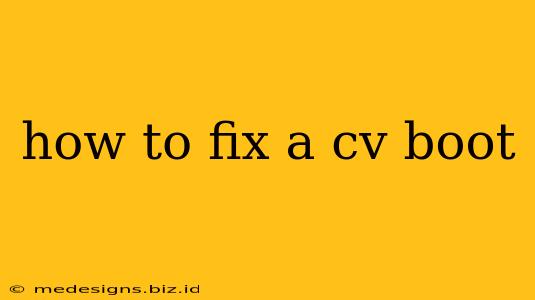A torn or damaged CV boot (constant velocity boot) is a serious problem that can quickly lead to costly repairs if left unattended. This vital component protects the CV joint, a crucial part of your vehicle's drivetrain, from dirt, dust, and water. Ignoring a damaged boot allows contaminants to enter the joint, leading to premature wear and eventual failure. This guide will walk you through the process of fixing a CV boot, saving you money and keeping your car running smoothly.
Understanding the Problem: Why CV Boots Fail
Before diving into the repair, it's important to understand why CV boots fail in the first place. Common causes include:
- Age and Wear: Over time, rubber degrades, making the boot more susceptible to cracking and tearing.
- Impact Damage: Striking a curb or driving over rough terrain can damage the boot.
- Improper Installation: Incorrect installation during previous repairs can weaken the boot.
- Extreme Temperatures: Exposure to extreme heat or cold can weaken the boot's material.
Identifying a Damaged CV Boot: Look for visual signs like cracks, tears, or grease leakage around the boot. If you notice any of these, it's crucial to address the issue promptly. Ignoring a damaged boot is like ignoring a slow leak in your tire – it will eventually cause a much bigger problem.
Tools and Materials You'll Need
Before you start, gather these essential tools and materials:
- New CV Boot Kit: This kit will typically include a new boot, clamps, and grease. Make sure you buy a kit specifically designed for your vehicle's make and model.
- Jack and Jack Stands: These are crucial for safely lifting your vehicle.
- Wheel Chocks: Essential for safety.
- Wrench Set: You'll need various sizes to remove and install components.
- Pry Bar: Helpful for removing stubborn clamps.
- Screwdrivers (Phillips and Flathead): Potentially needed depending on your vehicle.
- CV Joint Grease: Use only the grease specified in your kit.
- Shop Towels or Rags: For cleaning.
- Gloves: To protect your hands.
- Penetrating Oil (like PB Blaster): To help loosen stubborn bolts.
Step-by-Step Repair Process
This process can vary slightly depending on your vehicle's make and model, but the general steps remain the same. Always consult your vehicle's repair manual for specific instructions.
1. Preparing Your Vehicle
- Safety First: Park your vehicle on a level surface, engage the parking brake, and use wheel chocks for added safety.
- Lift and Secure: Use a jack to lift the vehicle, and securely place it on jack stands. Never work under a vehicle supported only by a jack.
- Remove the Wheel: Remove the wheel corresponding to the damaged boot.
2. Removing the Old Boot
- Remove the Clamp(s): Carefully remove the clamps securing the old boot using a pry bar or appropriate wrench.
- Inspect the CV Joint: Check the CV joint for any significant damage. If the joint is severely damaged, you'll need a replacement.
- Remove the Old Boot: Carefully remove the old boot. Clean the CV joint thoroughly using a clean rag.
3. Installing the New Boot
- Lubricate the New Boot: Apply a generous amount of CV joint grease to the inside of the new boot.
- Install the New Boot: Carefully install the new boot over the CV joint, ensuring it's properly seated.
- Secure the New Boot: Secure the new boot with the new clamps provided in the kit. Ensure the clamps are tight and securely fastened.
4. Reassembly
- Reinstall the Wheel: Reinstall the wheel and tighten the lug nuts to the manufacturer's specifications.
- Lower the Vehicle: Carefully lower the vehicle using the jack.
- Test Drive: Take your vehicle for a short test drive to ensure everything is working correctly.
Important Considerations
- If you're not comfortable performing this repair yourself, it's best to take your vehicle to a qualified mechanic. Incorrectly installing a CV boot can lead to further damage.
- Always use the correct type of CV joint grease. Using the wrong grease can damage the CV joint.
- Inspect your CV boots regularly as part of routine maintenance. Early detection of a problem can save you money in the long run.
By following these steps, you can effectively fix a damaged CV boot and avoid costly repairs. Remember safety and proper preparation are key. Happy driving!
